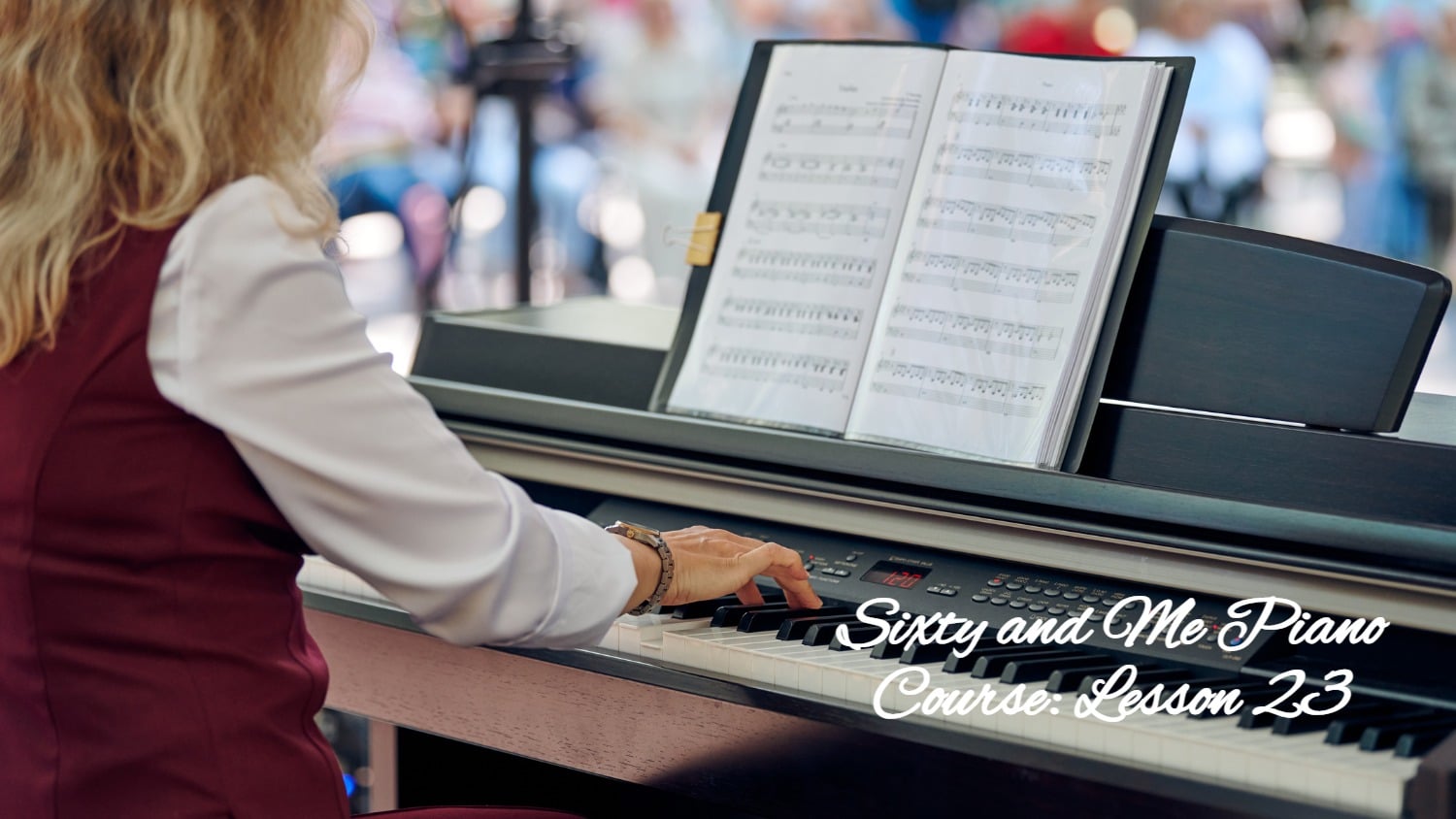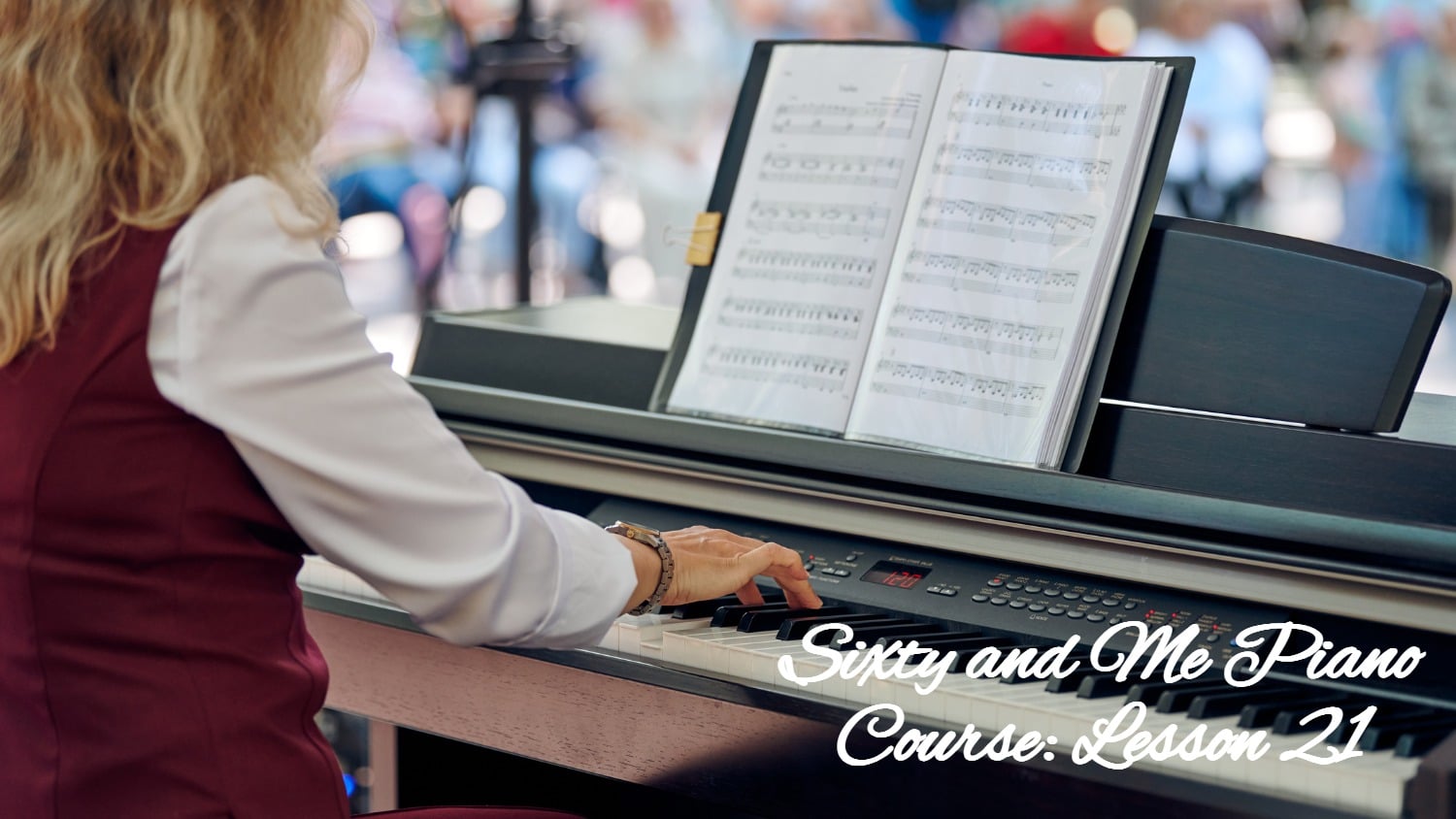
Piano Lesson 23: Holiday Music and Swing!
It’s Lesson 23 and this week we are skipping ahead to p.71 in your Upper Hands Piano, Book 1 to learn a new note and Swing rhythm, and we’re also learning some holiday songs, because there is no better way to celebrate than with music!
[NOTE: If you are just joining us for the first time, you can find my previous Sixty and Me Free Piano Lessons on my Author page. You can join our lessons any time and move at your own pace!]
23.1 Swing and New Treble Note A4 in Erie Canal p.71
On p.71 you learn a new treble note A4. This A is a skip below middle C and is the same A you learned in the bass staff on p.64 (see the bottom of p.71). The only difference is that this A is played with your right hand. As you can see, treble and bass notes can overlap. Higher notes are generally on the treble staff and lower notes on the bass staff; however, notes can be assigned to either the treble or bass staff depending upon which hand the composer wants you to use. A4 is 2 ledger lines below the treble staff.
Notice also that we use a Swing rhythm in Erie Canal. Swing means that the Eighth notes are played in a long/short bouncy rhythm instead of evenly. (Note: Quarter notes are still played evenly, as usual, we only “Swing” the eighth notes.) Watch this video I made in 2012 to demonstrate Swing for an earlier edition of my book. I was so young! 😊
23.2 Erie Canal slow demonstration, p.71
Here is a slower, overhead demonstration of Erie Canal. Notice that the fingering is a bit tricky as we add additional notes. Pay attention to the circled fingerings which alert you to move your hand, extend your fingers, or to cross fingers over, in order to reach all the keys:
I love the holidays, and this year I think we need music more than ever to bring joy and appreciation to our celebrations. I have arranged Sevivon, a traditional Hebrew Chanukah song, and Angels We Have Heard on High, a traditional Christmas Carol. These are a little beyond the level you have been playing, so start practicing now!
Note: You can always play right hand alone in passages where adding the left hand feels too difficult.
Neither song uses Swing rhythm, but you will be playing the new Treble note A4 in Sevivon, and that same note A4 in the Bass staff in Angels We Have Heard on High. I hope you find time to play them both! And to share your song(s) with family or friends during your holiday celebrations! Playing music is a great gift to loved ones.
23.3 Sevivon
(Print your Sixty and Me sheet music here – scroll down, bottom right.)
Sevivon is a song about Chanukah dreidels that also celebrates the miracles of life and light. On the third and fourth lines you will see that the fingering moves around quite a bit. For example, on the first note of the third line, you will need to move your hand to the right a bit to get your RH 3-finger on the E. Then notice in the third line, second measure, you will play that same E with your 4th, then your 5th finger.
It is not uncommon for a pianist to use a different finger when repeating a note. As you get more advanced, playing more keys, your hands have to cover a greater distance, and fingering gets more complicated.
Be very meticulous with your fingering! Play the song slowly, learning the fingering correctly from the start so that you don’t have to undo your fingering habits later. I chose this song for you specifically because it includes the new note you are learning in Erie Canal: A4, the A which is a skip below middle C in the treble staff.
23.4 Angels We Have Heard on High
(Print your Sixty and Me sheet music here – scroll down, bottom right.)
The tune of Angels We Have Heard on High comes from a traditional French Song with English lyrics that celebrate angels singing at the birth of Christ.
Notice you are playing the same A4 you learn in Erie Canal, but it is in the Bass staff and played with your left hand. You will move your left hand 1-finger from G to A then back to G in the first line, second and third measures, and the last line, third and fourth measures. It is not uncommon for pianists to move fingers around this way in more advanced music. So few fingers, so many keys! Watch my demonstration video to see what it looks like to move your 1-finger in this way:
Passion Practice
- Exercise #4 – Play in F# and D-flat with each hand. Try playing it using a metronome set to 3/4 time, at whatever tempo (speed) you can play it without pausing.
- Erie Canal p.71 – Watch my demonstration videos 23.1 and 23.2 above then practice the song slowly. There is no left hand in this song!
- Chord Calisthenics #4, Appendix viii – Play the minor triads from C minor to D-flat minor as whole notes, with each hand. After you learn F#m and Dbm, use a metronome and hold each chord (Cm-Dbm) for 4 beats at around 70 bpm. Record yourself to make sure you are staying on the beat!
- Holiday Songs – Print you sheet music HERE (scroll down to bottom right). Play Sevivon and/or Angels We Have Heard on High. They both include your new note A4, Sevivon in the Treble Staff, and Angels We Have Heard on High in the Bass staff. Watch the demonstration videos above to check your fingering and rhythm. If you prefer to not play holiday songs, please review Largo on p.57.
Let’s Have a Conversation!
Do you like the long-short lazy sound of Swing rhythm? Can you think of any songs with a Swing feel? Has music been a part of your holiday traditions? What are some of your favorite holiday songs?
Tags Piano Lessons






